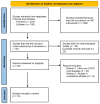Inspiratory Muscle Training in Patients with Chronic Obstructive Pulmonary Disease (COPD) as Part of a Respiratory Rehabilitation Program Implementation of Mechanical Devices: A Systematic Review
- PMID: 35564959
- PMCID: PMC9099727
- DOI: 10.3390/ijerph19095564
Inspiratory Muscle Training in Patients with Chronic Obstructive Pulmonary Disease (COPD) as Part of a Respiratory Rehabilitation Program Implementation of Mechanical Devices: A Systematic Review
Abstract
Chronic Obstructive Pulmonary Disease (COPD) is a complex and heterogeneous disease, with pulmonary and extrapulmonary manifestations, which leads to the need to personalize the assessment and treatment of these patients. The latest updates of national and international guidelines for the management of COPD reveal the importance of respiratory rehabilitation (RR) and its role in improving symptoms, quality of life, and psychosocial sphere of patients. Within RR, the inspiratory muscle training (IMT) has received special interest, showing benefits in maximum inspiratory pressure, perception of well-being, and health status in patients with chronic heart disease, respiratory diseases, and dyspnea during exercise. The aim of this review is to assess the efficacy of IMT in COPD patients through the use of inspiratory muscle training devices, compared with respiratory rehabilitation programs without inspiratory muscle training. In the last years, many mechanical devices focused on inspiratory muscle training have been developed, some of them, such as the AirOFit PRO™, PowerBreath®, or FeelBreathe®, have shown clear benefits. The active search for candidate patients to undergo the RR program with inspiratory muscle training using this type of device in COPD patients represents an advance in the treatment of this disease, with direct benefits on the quality of life of the patients. In this article, we review the available evidence on IMT in these patients and describe the different devices used for it.
Keywords: chronic obstructive pulmonary disease; inspiratory muscle training; inspiratory restriction device; quality of life; respiratory rehabilitation.
Conflict of interest statement
The authors declare no conflict of interest.
Figures
Comment in
-
Comment on Vázquez-Gandullo et al. Inspiratory Muscle Training in Patients with Chronic Obstructive Pulmonary Disease (COPD) as Part of a Respiratory Rehabilitation Program Implementation of Mechanical Devices: A Systematic Review. Int. J. Environ. Res. Public Health 2022, 19, 5564.Int J Environ Res Public Health. 2023 Mar 6;20(5):4629. doi: 10.3390/ijerph20054629. Int J Environ Res Public Health. 2023. PMID: 36901639 Free PMC article.
-
Reply to Yigit, S.; Akinci, B. Comment on "Vázquez-Gandullo et al. Inspiratory Muscle Training in Patients with Chronic Obstructive Pulmonary Disease (COPD) as Part of a Respiratory Rehabilitation Program Implementation of Mechanical Devices: A Systematic Review. Int. J. Environ. Res. Public Health 2022, 19, 5564".Int J Environ Res Public Health. 2023 Mar 9;20(6):4801. doi: 10.3390/ijerph20064801. Int J Environ Res Public Health. 2023. PMID: 36981710 Free PMC article.
Similar articles
-
Inspiratory muscle training compared with other rehabilitation interventions in adults with chronic obstructive pulmonary disease: a systematic literature review and meta-analysis.COPD. 2005 Sep;2(3):319-29. doi: 10.1080/15412550500218072. COPD. 2005. PMID: 17146997
-
Comparison of the effectiveness of inhaler devices in asthma and chronic obstructive airways disease: a systematic review of the literature.Health Technol Assess. 2001;5(26):1-149. doi: 10.3310/hta5260. Health Technol Assess. 2001. PMID: 11701099
-
Expiratory and expiratory plus inspiratory muscle training improves respiratory muscle strength in subjects with COPD: systematic review.Respir Care. 2014 Sep;59(9):1381-8. doi: 10.4187/respcare.02793. Epub 2014 Apr 29. Respir Care. 2014. PMID: 24782553
-
Inspiratory muscle training in adults with chronic obstructive pulmonary disease: an update of a systematic review.Respir Med. 2008 Dec;102(12):1715-29. doi: 10.1016/j.rmed.2008.07.005. Epub 2008 Aug 15. Respir Med. 2008. PMID: 18708282
-
Telehealth interventions: remote monitoring and consultations for people with chronic obstructive pulmonary disease (COPD).Cochrane Database Syst Rev. 2021 Jul 20;7(7):CD013196. doi: 10.1002/14651858.CD013196.pub2. Cochrane Database Syst Rev. 2021. PMID: 34693988 Free PMC article.
Cited by
-
Closing the Gap between Inpatient and Outpatient Settings: Integrating Pulmonary Rehabilitation and Technological Advances in the Comprehensive Management of Frail Patients.Int J Environ Res Public Health. 2022 Jul 27;19(15):9150. doi: 10.3390/ijerph19159150. Int J Environ Res Public Health. 2022. PMID: 35954506 Free PMC article. Review.
-
The Effectiveness of Home-Based Inspiratory Muscle Training on Small Airway Function and Disease-Associated Symptoms in Patients with Chronic Obstructive Pulmonary Disease.Healthcare (Basel). 2023 Aug 16;11(16):2310. doi: 10.3390/healthcare11162310. Healthcare (Basel). 2023. PMID: 37628507 Free PMC article.
-
Is Frailty Diagnosis Important in Patients with COPD? A Narrative Review of the Literature.Int J Environ Res Public Health. 2023 Jan 17;20(3):1678. doi: 10.3390/ijerph20031678. Int J Environ Res Public Health. 2023. PMID: 36767040 Free PMC article. Review.
-
Diaphragmatic dysfunction assessed by ultrasound: a key predictor of prolonged ventilation in emergency department.Intern Emerg Med. 2025 Jun 20. doi: 10.1007/s11739-025-04020-3. Online ahead of print. Intern Emerg Med. 2025. PMID: 40542246
-
Comment on Vázquez-Gandullo et al. Inspiratory Muscle Training in Patients with Chronic Obstructive Pulmonary Disease (COPD) as Part of a Respiratory Rehabilitation Program Implementation of Mechanical Devices: A Systematic Review. Int. J. Environ. Res. Public Health 2022, 19, 5564.Int J Environ Res Public Health. 2023 Mar 6;20(5):4629. doi: 10.3390/ijerph20054629. Int J Environ Res Public Health. 2023. PMID: 36901639 Free PMC article.
References
-
- Global Strategy for Diagnosis, Management, and Prevention of COPD. 2022. [(accessed on 1 February 2022)]. Available online: https://goldcopd.org/2022-gold-reports/



